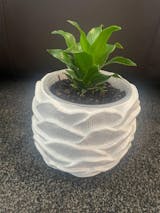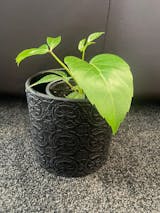
Phalaenopsis Orchid Care
You love the beauty of Orchids, but find them hard to care for? This comprehensive care guide has been written just for you! Follow these tips and your Orchids will bloom for months and love you back.
All you need to know to keep your Phalaenopsis Orchid happy
If I’m completely honest, I’d have to say that I feel sorry for Orchids. They tend to get labelled unfavorably, often classed as “temperamental” and “fussy” when, they can be one of the easiest houseplants to have in your home. And who doesn’t like a houseplant that has the potential to provide you with lasting blooms for most of the year?
Let’s start by understanding their natural environment – the environment where they thrive in abundance. This is where I like to start with all plants, as this tells you so much about a plant and what it prefers.
Orchids are ephiphytes, or more simply put “air plants.” In their natural environment, they attach themselves to trees with their long, fat roots, often in tropical rainforests. This important fact tells me so much. Firstly, their roots don’t grow in thick, suffocating soil and given they are naturally found in rainforests, that tells me that they love humidity.
Let’s now take a closer look at some key aspects of Orchid care and in particular, the care of the most popular Orchid found in our homes, the Phalaenopsis Orchid, or “Moth Orchid.”

Orchid watering needs
Like the care of most houseplants, watering is quite possibly the most important part of caring for an Orchid. You must get this right to ensure a thriving Orchid!
The Phalaenopsis Orchid prefers to remain somewhat moist, but that doesn’t mean long periods of being sopping wet. In fact, it’s good for it to dry out a little in between watering and if in doubt, it’s better to under rather than overwater these, as the biggest mistake people usually make with Orchids, is killing them with kindness by overwatering them. The amount of water is also important, and I find that often people are nervous that they are going to overwater their Orchid, so they only give it a dribble. Reality in its natural environment, however, is anything but a little dribble. Instead, these are used to cycles of being almost flooded (torrential downpours) and then long periods of virtually nothing. This is why their roots are so thick, they absorb and retain moisture to allow the plant to adapt and keep thriving during these dry periods.
So, when you water an orchid, water if well! Take it over to the sink and completely drench the soil, ensuring there is drainage and water until it flows out the bottom of the pot. Make sure you are wetting the whole area, and not just partially. Allow any excess water to drain away before placing it back in a cover pot if you have one.
You will then want to wait for the soil to dry out again before giving it another drenching. Ideally, once the top inch of the soil has dried, your Orchid is ready for another drink. This is usually around 4-5 days in summer and up to 10 days during the cooler months, but it really does depend on how warm the room is and the amount of light it receives (the brighter the room, the more frequently plants will require a watering).
You will often find that Orchids are planted in a clear pot and there are a couple of reasons for this. Their roots like to photosynthesis and need light to do this. Although they are often fine in a cover pot. But you can also see the roots through these clear pots, and this can help you to determine when an Orchid needs to be rewatered. Generally, the roots will be a whitish/grey colour when it is overdue a water and a green colour when well hydrated. Take note next time you water and watch the roots change colour but don’t leave them to the point where they start to shrivel. Healthy roots = a healthy, thriving Orchid and you can check the roots by keeping them in a clear pot.
What light do Orchids like?
If we come back to their natural environment, they are often shaded by big trees. They therefore will not like a room that is too bright. In saying that, they do need enough light to flower. Ensure the room has good natural light and no direct sunlight. Back from a window should be fine, just make sure that sunlight doesn’t touch it throughout the day as it moves around the room.
What soil do Orchids like?
Another important factor to get right when caring for an Orchid, is the soil that it’s sitting in. Remember, in their natural environment, they are used to growing by attaching themselves to a tree. Their roots are therefore exposed, and air is able to freely circulate around them. It is for this reason, that you wouldn’t pot an Orchid in normal houseplant potting mix. They need air to circulate around their roots and therefore an Orchid bark is the best option. You will want to ensure that the bark isn’t too tightly compacted around the roots to allow the circulation that its used to.
You will ideally want to repot your Orchid into fresh Orchid bark once a year. The best time to do this is when the plant stops flowering. Orchids prefer a smaller pot than what you’d expect – the plant will almost look too small for the pot, so don’t go too big. If you start to see lots of the roots growing out of the pot, this is a good indication that it’s time for a repot and you’ll only want to go up an additional 2-3cms in diameter.
You are also best not to rewater straight after repotting. Let the plant settle for a few days before watering.

Why is my Orchid not flowering?
There are couple of reasons why your Orchid may stop blooming. Firstly, you may need to repot it and give it some fresh soil. Secondly, these need a drop in temperature to trigger flowering. This will usually occur in winter, so ensure during the evenings, that your Orchid isn’t kept in a really warm room with heating. Move it to a cooler room so it triggers the flower to bloom.
The last reason for an Orchid not flowering, is a lack of nutrients. There are two products we recommend here. A ready to use mist to protect your orchids from the damaging dry environments found in modern homes. We have used Orchid Mist and Feed with great success. The foliar feed is rapidly absorbed and ensures healthy glossy green leaves and longer lasting blooms as well as promoting the formation of new flower spikes.
During the growing season, your Orchid may need more than just a misting. So, we recommend Orchid Pump and Feed to provide your Orchid with the boost it needs to continue blooming for many months.
You may notice flower spikes on your Orchid during Spring. This is a good indication that flowers are on their way! After flowering, the spike will remain and may turn yellow. You are best to snip this off about 2-3cms from the base of the plant. This will encourage re-flowering.
You’ll also want to ensure that you keep the leaves dust free. Regularly wipe them down with a damp cloth. This will promote healthier growth.
Why has my Orchid’s leaves turned yellow/brown or gone wrinkly?
The leaves of an Orchid will often turn yellow due to incorrect watering. Either under, or overwatering. If the soil is kept consistently wet, overwatering will be the likely cause. The leaves can also turn yellow if the light is too bright.
The cause of wrinkly Orchid leaves is usually due to underwatering. So, if the leaves are wrinkled and yellow, underwatering is the likely cause. You will notice that the leaves will also droop and wilt if the plant is underwatered. Remember also, that Orchids are humidity lovers which we don’t usually create in our homes. You can place your Orchid on a pebble tray with the water line under the pebbles. Water will then evaporate up and around your Orchid, increasing the humidity. Placing your Orchid close to other plants will also increase the humidity.
Another cause for the leaves to discolour, could be a lack of nutrients. So, if it’s been a while since you fed your baby, now would be a good time.
Key Tips for Orchid care
- Ensure you pot your Orchid in the correct medium – a quality Orchid bark is best
- Repot once a year, after blooming
- Keep the pot on the smaller side – Orchids prefer to be restricted in their pots
- Completely saturate the pot when you water, until water comes out of the drainage holes of the pot. Allow the top inch of bark to dry before rewatering. Don’t sit the pot in water, as this will increase the likelihood of root rot. Ensure the pot has fully drained before placing back into a cover pot
- Ensure the plant is exposed to cooler temperatures in winter – this will trigger flowering
- Trim the flower spike when blooming finishes – 2-3cms from the base of the plant
- Keep the plant in a room that’s not too bright and out of any direct sunlight
- Mist regularly and remember to fertilise with a good quality Orchid food
- Place near other plants or on a peeble tray to increase the humidity
I truly hope this has helped you to feel more confident about caring for your Orchids. They really are a thing of beauty and can be easy to care for, you just need to follow the key tips above. As always, if you have further questions, please don’t hesitate to get in touch. I love talking all things plants and would be more than happy to help you any time.
If you don’t want to miss regular tips such as these, sign up to our emails and we will be sure to stay in touch and provide you with lots of straightforward advice. You’ll also be the first to know when we release new products or have specials.
Orchids
Feeling a little more confident with Orchid care? Find your perfect match here.
Complimentary Plant Care
We only stock what we have tried and tested and personally love































